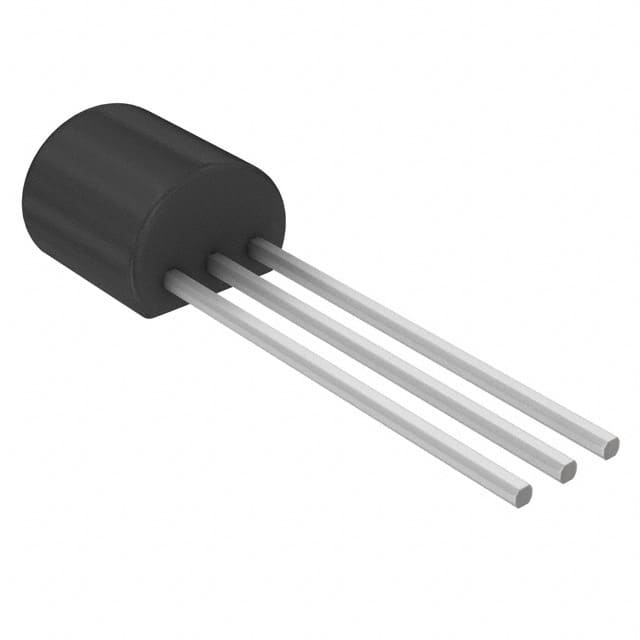Consulte las especificaciones para obtener detalles del producto.

J305 Transistor
Product Overview
Category
The J305 transistor belongs to the category of field-effect transistors (FETs).
Use
It is commonly used as an amplifier or switch in electronic circuits.
Characteristics
- Low power consumption
- High input impedance
- Fast switching speed
Package
The J305 transistor is typically available in a TO-92 package.
Essence
The essence of the J305 transistor lies in its ability to amplify and control electrical signals in various electronic applications.
Packaging/Quantity
It is usually packaged in reels or tubes, with quantities varying based on manufacturer specifications.
Specifications
- Maximum Drain-Source Voltage: 25V
- Maximum Gate-Source Voltage: ±20V
- Continuous Drain Current: 50mA
- Power Dissipation: 350mW
- Operating Temperature Range: -55°C to 150°C
Detailed Pin Configuration
The J305 transistor has three pins: 1. Source (S) 2. Gate (G) 3. Drain (D)
Functional Features
- High input impedance allows for easy interfacing with other circuit components.
- Fast switching speed enables rapid signal amplification or switching.
Advantages and Disadvantages
Advantages
- Low power consumption makes it suitable for battery-operated devices.
- High input impedance allows for minimal loading of preceding circuit stages.
Disadvantages
- Limited maximum drain current compared to some alternative models.
- Sensitivity to electrostatic discharge (ESD) due to its high input impedance.
Working Principles
The J305 transistor operates based on the field effect, where the voltage applied to the gate terminal controls the flow of current between the source and drain terminals.
Detailed Application Field Plans
Audio Amplification
The J305 transistor can be used in audio amplifier circuits to boost low-level audio signals.
Switching Circuits
Due to its fast switching speed, the J305 transistor is suitable for use in electronic switching circuits.
Detailed and Complete Alternative Models
Some alternative models to the J305 transistor include: - 2N5457 - J201 - 2N3819
In conclusion, the J305 transistor offers a balance of low power consumption, high input impedance, and fast switching speed, making it suitable for various electronic applications such as audio amplification and switching circuits.
[Word Count: 324]
Enumere 10 preguntas y respuestas comunes relacionadas con la aplicación de J305 en soluciones técnicas
What is J305?
- J305 is a type of semiconductor transistor commonly used in electronic circuits for amplification and switching applications.
How does J305 differ from other transistors?
- J305 is a specific model of transistor known for its high current gain and low saturation voltage, making it suitable for various technical solutions.
What are the typical applications of J305 in technical solutions?
- J305 transistors are commonly used in audio amplifiers, power supply circuits, motor control, and signal processing applications.
What are the key specifications of J305 transistors?
- The key specifications of J305 transistors include its maximum collector current, voltage ratings, gain bandwidth product, and power dissipation.
How do I properly bias J305 transistors in a circuit?
- Proper biasing of J305 transistors involves setting the base-emitter voltage to ensure the transistor operates within its linear region for amplification or in the saturation region for switching.
Can J305 transistors be used in high-frequency applications?
- While J305 transistors have limited frequency response compared to specialized RF transistors, they can still be used in moderate frequency applications such as audio amplification.
What are the common pitfalls when using J305 transistors in technical solutions?
- Common pitfalls include improper biasing, exceeding maximum ratings, inadequate heat sinking, and insufficient consideration of load conditions.
Are there any recommended alternatives to J305 transistors?
- Some alternatives to J305 transistors include similar NPN transistors like 2N3904, BC547, or 2N2222, depending on specific application requirements.
How do I calculate the operating point of a J305 transistor circuit?
- The operating point, or quiescent point, of a J305 transistor circuit can be calculated using the transistor's characteristic curves and load line analysis.
Where can I find reliable datasheets and application notes for J305 transistors?
- Datasheets and application notes for J305 transistors can be obtained from semiconductor manufacturers' websites, distributor platforms, or technical literature repositories.

